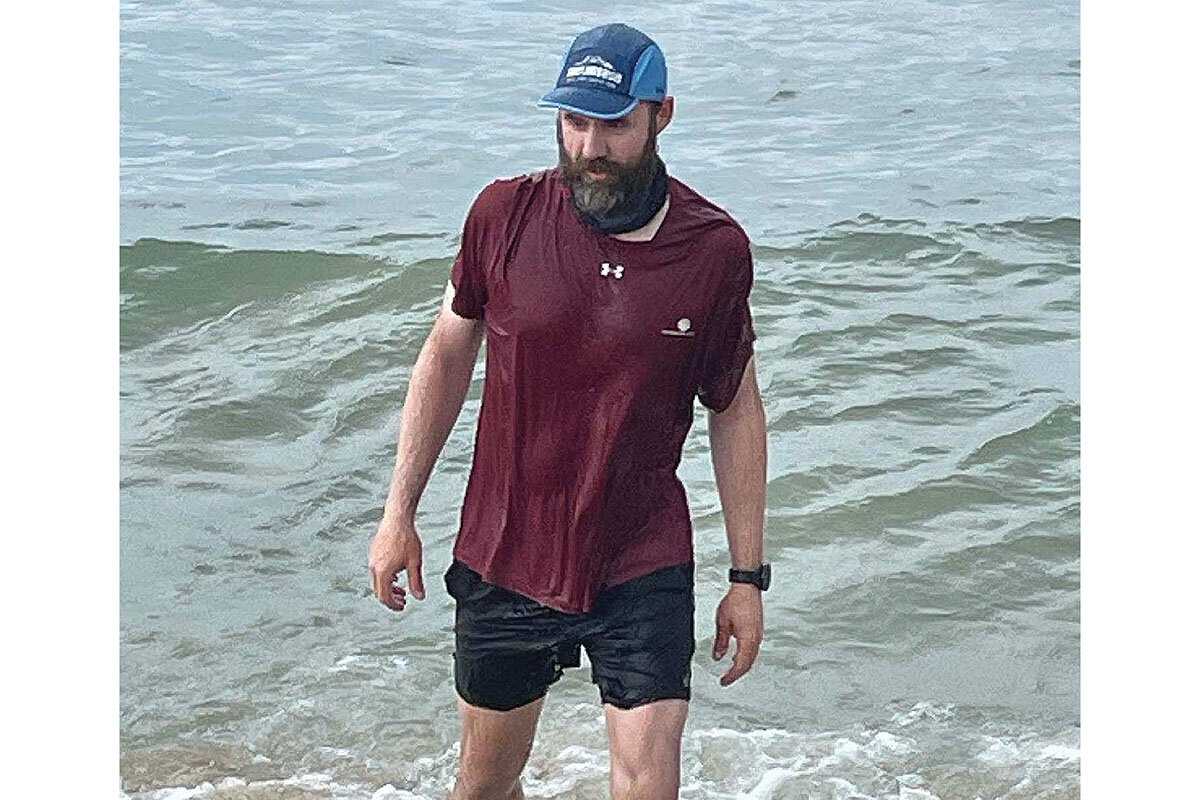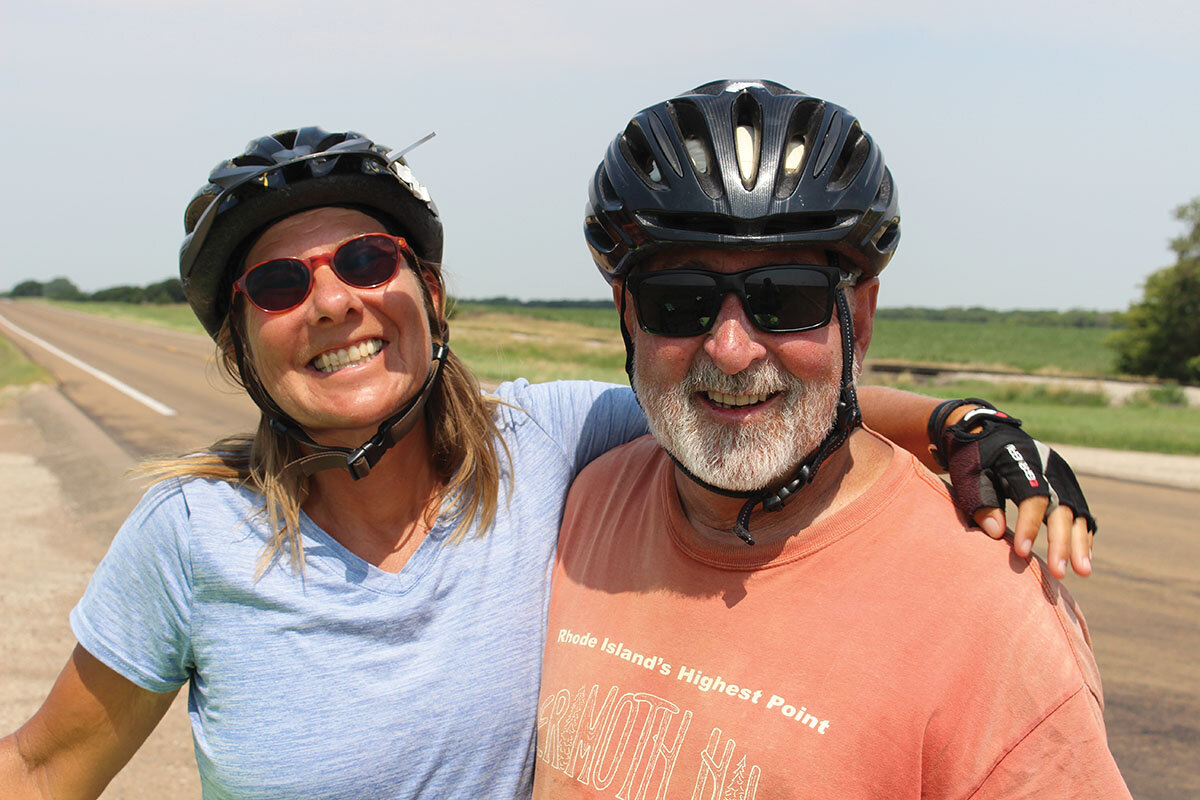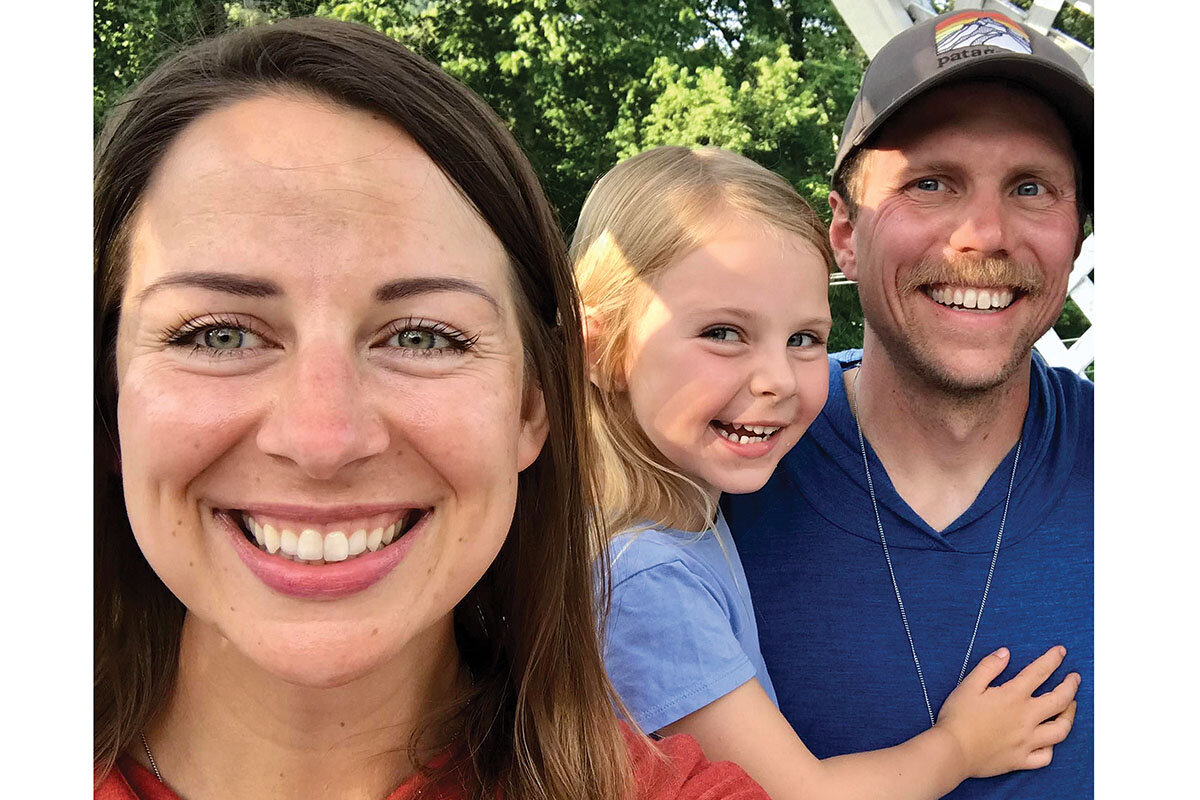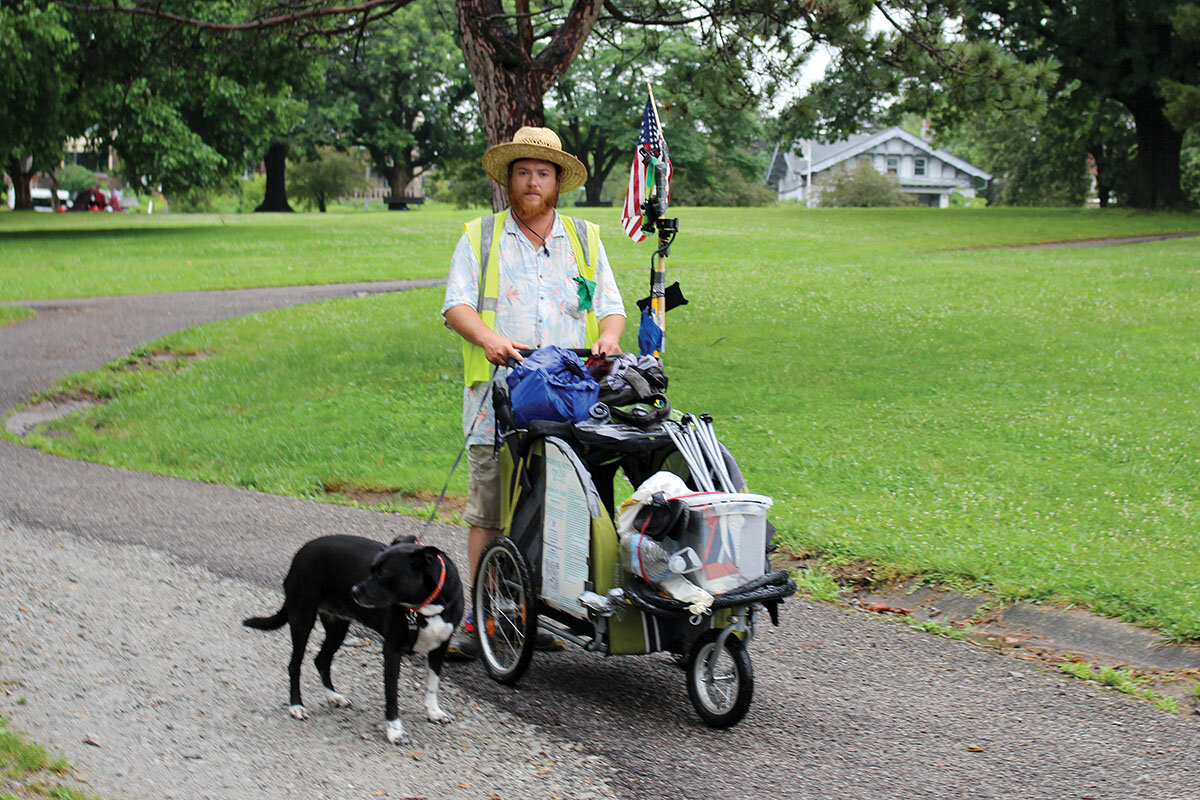By bike and by foot, Americans discover their country – and themselves
Loading...
| On the road in the U.S.
Crossings please the soul. Large or small, they mark an accomplishment: the “t” crossed, the to-do item marked off, the dots connected. The dots may be two huge blue oceans.
“You look at a U.S. map, and you see water on one side, and water on the other side,” says Jarad Schofer, a high school math teacher who walked from Santa Monica, California, to Virginia Beach, Virginia, this year. “You think, to cross it would be incredible.”
As the pandemic has eased and cooped-up quarantine dreams have been unleashed, a small troop of wanderers is walking or bicycling from one side of this country to another. It is a grueling effort – enduring historic heat, grinding inclines, gas station food, and phone-distracted drivers.
Why We Wrote This
A large number of people are crossing the United States on foot and by bike. To some, it’s an act of liberation. To others, it fosters a sense of community after pandemic isolation. For all of them, traversing the country at a slow pace offers the reward of the landscape’s grandeur.
Most love it.
They say it fulfills something: a personal challenge, an escape from routine, a connection with others, an insight into themselves. They say they are finding what they sought on the road.
“It’s not about what you see, it’s all the people you meet,” says bicyclist Zach Wierzenski, stopped at a hostel in Virginia. “When you’re in trouble, somebody shows up. It’s literally magic. I have never experienced this kind of kindness before.”
No permit is required to wander about the country, so there are no firm numbers, but some estimate about a dozen walkers and several hundred cyclists cross the country in most years. The pandemic throttled those numbers, though the quarantines did boost bike sales and spurred the impatient to begin training. When COVID-19 eased, they leaped onto the roads.
“It was because of the pandemic. After all of that isolation, we wanted to connect with people,” says Meghan Sours of her family trek. They launched from Virginia on June 17 in an unusual formation: Ms. Sours and her husband, Bryan, riding bicycles, with 5-year-old Inness in a trailer behind her father’s bike.
They stop at playgrounds and sleep in churches and campsites – and some hotels – as many of the crossers do. But “we have to have a bathroom,” says Mr. Sours, a social studies teacher from Provo, Utah, hoping to finish the journey before the start of school in September.
“For [Inness] it’s a really big adventure,” says Mr. Sours. “How many 5-year-olds can get to say they slept in a fire station?”
Why do these slow voyagers do it? Courtney Williams sighs at the question. Ms. Williams, sipping a bubble tea while stopping at the Blend Tea and Crepe Lounge in Carbondale, Illinois, shrugs. “Because I can? As clichéd as it sounds, it’s not a bad answer.”
Her bike rests by the store – two yellow cat litter containers strapped on as makeshift saddlebags, her ukulele and a foldable hula hoop secured to the front frame. “I’ve always liked to hula-hoop. I have a speaker and turn on the music and dance,” she explains.
The crossers get asked “why” so often they all have practiced answers to skirt deeper delving. Ms. Williams through-hiked the 2,190-mile Appalachian Trail as a teenager, and says she has been backpacking and living in her car off and on for years. A solo bike crossing seemed natural.
Biking alone, Ms. Williams says, “I get asked a lot if I carry a gun.” She hasn’t needed one, she says, but “as a woman, I am more cautious in general. I don’t tell people where I’m staying. I carry Mace – though that’s [to appease] my mom. If a car stops, my first instinct is a bit of panic but then they are just saying, ‘Are you OK?’”
America at a slow pace offers the reward of grandeur: the turbulent creases of the Appalachians on the East, the blazing colors of vast fields and sky in the heartland, the exhilarating heights of the Rockies in the West.
Some crossers say they just want to look over the next hill. “I’ve been perpetually restless all my life,” says Mr. Wierzenski, a Virginia Beach auto mechanic pedaling to Oregon who says he just might stay there. “One day I was on my way to work and my feet just wouldn’t work. They walked me around to the side of the building; I looked at the bike, stared off into the sun. And that’s the way I went.”
Indeed, an elemental thirst for liberation seems key. American philosopher Vernon Howard said, “Our freedom can be measured by the number of things we can walk away from.” Many of the crossers say they feel unburdened by the daily obligations of life on their journeys. They are required to focus only on the next step or rotation of the pedal.
Mike Crowley walked coast to coast in 2019. Toward the end, someone suggested a north-to-south trek. “I thought, ‘that’s stupid,’” Mr. Crowley recalls thinking. But seven months later he was in the northernmost tip of Michigan, embarking on a walk to Key West, Florida.
Mr. Crowley, who sold his home in California to begin a life of traipsing – he is planning his third cross-country trip now – says he does not listen to music or podcasts or pay attention to social media on his walks. “I just observe and listen and let nature and people and places just kind of soak in.”
There is much to enjoy. “I love it that you can stop whenever you see something beautiful – a turtle, a bald eagle, a mountain,” says Swantje Quarder, a German-born professor at Idaho State University in Pocatello, cycling with her husband on day 46 of their trip. They paused on a pencil-straight Kansas road bisecting hayfields. “You can smell the air, and hear the air. All the senses kick in.”
There is an old appeal to shedding the high-speed view of life that comes with the modern age. A fellow named Brian Christopher Hurley wrote a 251-page dissertation on walking for his doctorate of philosophy in history from the University of Arkansas in 2016. In addition to clocking 1,700 miles of his own from Maine to Illinois, Mr. Hurley studied the epic traipsing of five historical figures: naturalist John Muir, journalist Charles Fletcher Lummis, and three others.
He concluded they had walked to recapture the evolutionary nature of man and the social development that comes with experiencing life at 3 miles per hour amid societal change.
“Walking was a way for Americans at the turn of the century to stay connected with their past while [society was] undergoing rapid modernization,” he wrote. “It was a way to preserve individual while fostering community. It allowed them to connect with the natural world while increasingly being separated from it. It let them focus on the physical in the face of the mechanical.” That is largely lost now, Mr. Hurley wrote.
He relates an anecdote of walking from Maine to New York, and asking a liquor shop owner in the Bronx directions to walk the mile or so to Yankee Stadium. The shopkeeper was befuddled, and could not envision why anyone would walk the short distance to Yankee Stadium rather than take the subway or bus.
“The man at the liquor store had a mental map of the South Bronx that looked, I imagine, much like a subway map,” Mr. Hurley concluded. “In his world, two locations are joined not by streets and air and grass, but by the train car that you enter.”
Cycling, on the other hand, is a more recent passion for Americans. Greg Siple recalls in the 1960s “you didn’t see adults ride bicycles. Bikes were for kids. When you turned 16, you turned in your bicycle and got a car.” But it was a free-spirit era, and Mr. Siple, his wife, and another couple wanted adventure, so they cycled 18,000 miles from Alaska to Argentina. They returned to the U.S. just before the 1976 bicentennial, and decided to create an event for people to cycle 4,626 miles, coast to coast from Astoria, Oregon, to Yorktown, Virginia.
“In the summer of ’76 we had 4,000 people riding part or all of the trail,” says Mr. Siple by phone from his home in Montana. “It was meant to be an event, but it was so successful, we decided to make it into an organization,” the Adventure Cycling Association.
The group now has mapped a spaghetti-like array of U.S. bike trails in GPS and paper form. Mr. Siple retired from the association in 2017, after seeing cycling flourish, with $3,000 touring bikes, special cleats, spandex biking pants, and tens of thousands of adherents, many of them following the green “76” highway sign created for his bicentennial route.
“It’s accessible to everyone,” Mr. Siple says of the transcontinental venture. “It doesn’t require explosive athleticism. It just requires determination.”
Both walkers and cyclists say a chief reward of their labors is the opportunity to strike up conversations and meet people.
“Everyone that we have encountered, they are so incredibly kind,” says Ms. Sours. “It’s been soul nourishing.”
For Cole Irvin, who took a challenge from a co-worker at a group home in Summerdale, Alabama, to bike across the country together this summer, the trip taught him to deal with the now.
“To be present in your surroundings, seeing everything at a 10 mph pace, smelling the smells, feeling the weather, going across Kansas when a thunderstorm falls on you,” he says. “You are forced to be in the present. I found peace in it.”
Or it can change people’s views of the future. Campbell Veasey and three other first-year medical students from Wake Forest University in Winston-Salem, North Carolina, joined another friend to bike across the country on the last free summer they will have before continuing their training. Siena Hapig-Ward joined the group when Mr. Veasey was practicing doing an ultrasound on her neck artery, and said, “By the way, you want to bike across country?”
Two days from finishing their odyssey in Winston-Salem, Mr. Veasey says, “This trip made me pretty pumped about helping work with people in rural communities. Like, your only food source is that Dollar General?” He and Ms. Hapig-Ward now are both thinking of opening rural practices. “We are getting an appreciation for how tough life is for rural America,” Mr. Veasey says.
There is crossover between the two groups; some of the cyclists are veteran hikers and vice versa. They intermingle at hostels or campgrounds. But each group keeps its preference for its mode of transportation. Hikers think bikers miss too much, and bikers shake their heads at the turtle crawl of the hikers. A walk across America can typically take nine months; bikers can make it in three.
Or six years. Four pals from Pittsburgh, all but one retired, have been crossing America on bicycles in chunks since 2016. Every summer, they drive to their last stopping point, and then ride another section of road. This year, they were cycling from Kansas City to southwest Colorado. They skipped last year because of the pandemic, but think they will finish the trip in 2022.
They stopped at a Frigid Crème frozen custard shop in Dighton, Kansas, to chat. No hurry, they said.
“I worked all my life and lots of weekends. Now it’s time to enjoy things I want to do,” says Fred Parker, a retired medical technologist.
“It’s kind of a test to see if you can still do it,” admits Chuck Ejzak, who celebrated his 65th birthday with pecan pie and Cool Whip along the road.
But others definitely are in a hurry. Peter May is a wiry, athletic 22-year-old from San Francisco. He paused briefly at a convenience store in Tribune, Kansas, to gulp several bottles of water and grab some fried chicken – his only food on a day in which he was pedaling 210 miles. “My personal best!” he exclaims. “My previous best was 125 miles” the day before.
Mr. May has only three weeks left to get to Boston. He had dawdled in Colorado, ironically, to compete in a national mountain biking competition (he placed ninth), and spent more time detouring on the Colorado Trail.
But even Mr. May has priorities other than speed. He refuses to pass a bakery without stopping, sometimes twice in the same block.
“That puts me at around 60 or 70 bakeries so far,” Mr. May calculates. The next day he texts photos from 95 miles down the road of three pies and a cinnamon bun he consumed at different bakeries that day – pretty average, he says, though “one might consider that extreme.”
Many of the crossers also have Facebook pages or GoFundMe sites to raise money for causes. Mr. Schofer walked to support cancer research. Sam Green is walking to help a homeless shelter in New Jersey. The Sours are riding to raise money for teeth implants for a Ukrainian friend affected by the Chernobyl nuclear disaster.
Australian sociologist Catherine Palmer studies what she calls “fitness philanthropy.” She says it is a global phenomenon. The philanthropy is part of – but rarely the main motive behind – these exploits, she says.
“The satisfaction that you get from that physical accomplishment is really something important,” she says by phone from her home in Tasmania. “But also, if you’re able to make a financial contribution to a cause that you’ve been involved with, or touched in some way, that’s a really important driver.”
There are easier ways to raise money for a good cause. But the hardship may be the point. A 2011 study co-written by Princeton professor Eldar Shafir called it “the Martyrdom Effect.” The researchers concluded “willingness to contribute to a charitable cause increases when the contribution process is expected to be painful ... rather than easy and enjoyable.”
That can certainly fit an American crossing. “I describe it as about 90% torture and 10% fun,” says Mr. Schofer, the Washington, D.C., math teacher. “I didn’t really know it was going to be that bad.” He started walking in Santa Monica nine months after he was married, and leaped in the Atlantic at Virginia Beach a stunning 89 days later.
He was anxious to return to his new bride, he says, and he took no time to relax. He hated much of the journey, he confesses. “I wanted to quit 100 times the first week.” But “I would have felt like such a failure.” His students, he notes, were watching by Facebook.
Sam Green, who is walking east to west with his pit bull mix, Taylor Ham, makes regular videos, often venting about the traffic, the weather, poison ivy, and faulty directions from his GPS.
“It’s way harder than I thought,” he says at a stop just shy of Pittsburgh July 1. He pushes his 70-pound dog in a cart. “I figured it’d be a really great adventure for her, too,” he explains. “But now, I’m realizing she doesn’t care.”
On the flip side, for sheer exuberance, the award goes to a husband-wife team from Minnesota who are walking east to west. Erin Dietrich and Chris Rea tolerate no suggestions that their endeavor has a downside.
Are they glad they are doing it, the couple is asked in the eye-blink town of Kiowa, Colorado, on day No. 132 of their walk? “One hundred percent,” says Mr. Rea.
“One million percent,” corrects his wife.
The walk was the idea – the passion, really – of Ms. Dietrich.
“The idea showed up” 15 years ago, she says. “This one never went away. It got in my head and it stayed.” She planned to walk with a friend, but the friend disappeared. “Just ghosted me,” says Ms. Dietrich, bewildered. “She was my bestie. It was ... heartbreaking.”
In stepped her husband, who pondered the trip for about a year, and realized he really wanted to go. He quit a good job of 20 years at a hardware store; she quit her data analyst job. They rented out their home near Minneapolis, and traveled to Delaware to begin the walk.
“I couldn’t imagine not sharing it with you,” Mr. Rea says to Ms. Dietrich, as they get ready to snuggle into their tent, pitched in a backyard offered up by a helpful stranger. “I love that we do that together.”
Ms. Dietrich has a childlike excitement at stumbling onto the World’s Largest Ball of Twine in Cawker City, Kansas, or the Pencil Sharpener Museum in Logan, Ohio, or the goat that accompanied them for six miles. Strangers cannot help but be swept up in her enthusiasm.
The worst thing is going to be when it’s over, the couple concludes. “The greatest experience of my life – it’s half done,” says Ms. Dietrich. “I mean, that’s just so sad.”
“It’s going to be super bittersweet,” Mr. Rea agrees. “We don’t want it to end.”











